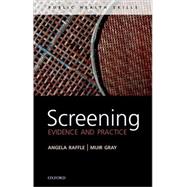
| Foreword | p. ix |
| Preface | p. xi |
| Endorsements | p. xiii |
| Acknowledgements | p. xv |
| How screening started | p. 1 |
| The aim of the chapter | p. 1 |
| Pre-modern screening | p. 1 |
| Modern screening | p. 9 |
| Post-modern screening | p. 28 |
| Summary points | p. 29 |
| Test yourself | p. 30 |
| What screening is, and is not | p. 33 |
| The aim of the chapter | p. 33 |
| Definitions and meanings | p. 33 |
| What we mean by screening | p. 34 |
| Formal definitions of screening | p. 35 |
| Where screening fits in the disease pathway | p. 38 |
| Other kinds of testing in people without signs or symptoms | p. 39 |
| Screening is ethically different from clinical practice | p. 41 |
| Principles of screening | p. 42 |
| Genetics and screening | p. 52 |
| Summary points | p. 55 |
| Test yourself | p. 56 |
| What screening does | p. 59 |
| The aim of the chapter | p. 59 |
| Putting people through the screening system | p. 60 |
| The experience for those being screened | p. 70 |
| The system and its outcomes | p. 76 |
| Summary points | p. 81 |
| Test yourself | p. 82 |
| Measuring what screening does | p. 85 |
| The aim of the chapter | p. 85 |
| Three main sources of bias in screening evaluation | p. 86 |
| Three main methods for evaluating screening | p. 97 |
| Two additional sources of information | p. 111 |
| Measures of test performance | p. 113 |
| Summarizing all information on outcomes | p. 116 |
| Summary points | p. 122 |
| Test yourself | p. 124 |
| Implementing screening | p. 127 |
| The aim of the chapter | p. 127 |
| Drivers for unplanned screening | p. 128 |
| Implementing from scratch | p. 129 |
| Creating order out of chaos | p. 149 |
| Summary points | p. 153 |
| Test yourself | p. 154 |
| Quality assuring screening programmes | p. 155 |
| The aim of the chapter | p. 155 |
| Why quality assurance is essential in screening | p. 155 |
| Some history | p. 156 |
| Applying quality assurance to screening | p. 160 |
| Summary points | p. 174 |
| Test yourself | p. 175 |
| Day to day management of screening for public health practitioners and programme managers | p. 179 |
| The aim of the chapter | p. 179 |
| Coping with demand for, or provision of, inappropriate screening | p. 181 |
| Problem solving in existing national programmes | p. 192 |
| Handling concerns about commercial sector screening | p. 196 |
| Screening and the law | p. 198 |
| Handling the media | p. 205 |
| Summary points | p. 211 |
| Test yourself | p. 212 |
| Making screening policy | p. 215 |
| The aim of the chapter | p. 215 |
| Who makes policy decisions about screening? | p. 217 |
| What kind of decisions have to be made? | p. 217 |
| How screening decisions are made | p. 218 |
| Evidence and resources | p. 218 |
| Using evidence for policy making | p. 220 |
| The importance of values | p. 231 |
| The importance of beliefs | p. 235 |
| The importance of commercial interests | p. 240 |
| The ethics of policy making | p. 244 |
| To conclude | p. 256 |
| Summary points | p. 257 |
| Test yourself | p. 259 |
| Answers | p. 263 |
| Glossary | p. 285 |
| References | p. 297 |
| Index | p. 313 |
| Table of Contents provided by Ingram. All Rights Reserved. |
The New copy of this book will include any supplemental materials advertised. Please check the title of the book to determine if it should include any access cards, study guides, lab manuals, CDs, etc.
The Used, Rental and eBook copies of this book are not guaranteed to include any supplemental materials. Typically, only the book itself is included. This is true even if the title states it includes any access cards, study guides, lab manuals, CDs, etc.